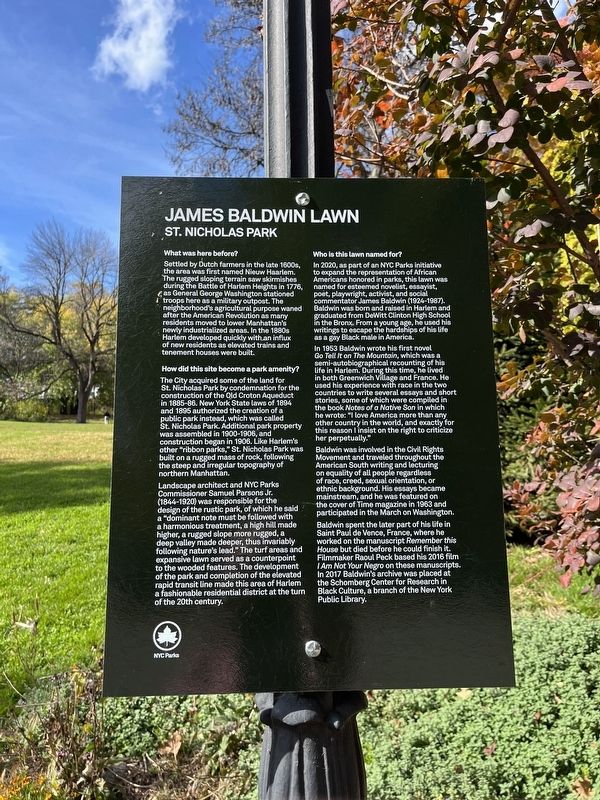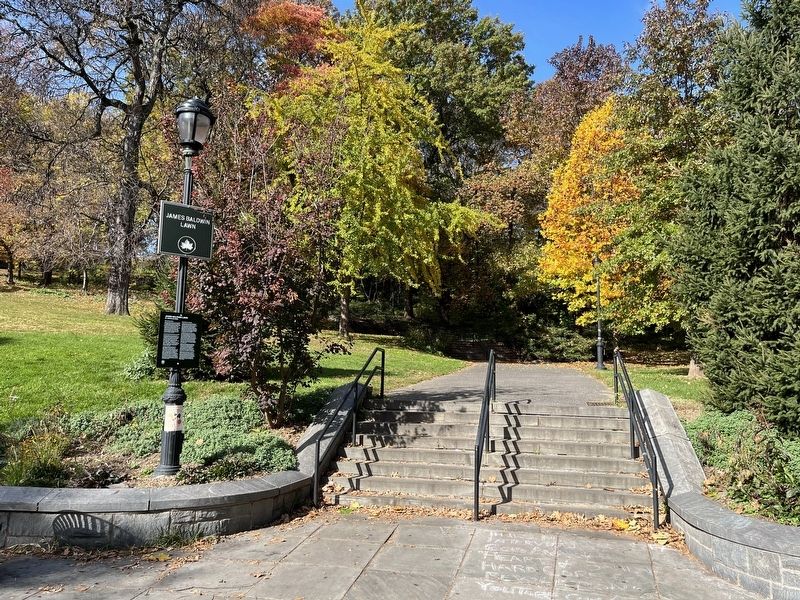Hamilton Heights in Manhattan in New York County, New York — The American Northeast (Mid-Atlantic)
James Baldwin Lawn
St. Nicholas Park
What was here before?
Settled by Dutch farmers in the late 1600s, the area was first named Nieuw Haarlem. The rugged sloping terrain saw skirmishes during the Battle of Harlem Heights in 1776, as General George Washington stationed troops here as a military outpost. The neighborhood's agricultural purpose waned after the American Revolution as many residents moved to lower Manhattan's newly industrialized areas. In the 1880s Harlem developed quickly with an influx of new residents as elevated trains and tenement houses were built.
How did this site become a park amenity?
The City acquired some of the land for St. Nicholas Park by condemnation for the construction of the Old Croton Aqueduct in 1885-86. New York State laws of 1894 and 1895 authorized the creation of a public park instead, which was called St. Nicholas Park. Additional park property was assembled in 1900-1906, and construction began in 1906. Like Harlem's other "ribbon parks," St. Nicholas Park was built on a rugged mass of rock, following the steep and irregular topography of northern Manhattan.
Landscape architect and NYC Parks Commissioner Samuel Parsons Jr. (1844-1920) was responsible for the design of the rustic park, of which he said a "dominant note must be followed with a harmonious treatment, a high hill made higher, a rugged slope more rugged, a deep valley made deeper, this invariably followed nature's lead." The turf areas and expansive lawn served as a counterpoint to the wooded features. The development of the park and completion of the elevated rapid transit line made this area of Harlem a fashionable residential district at the turn of the 20th century.
Who is this lawn named for?
In 2020, as a part of NYC Parks initiative to expand the representation of African Americans honored in parks, this lawn was named for esteemed novelist, essayist, poet, playwright, activist, and social commentator James Baldwin (1924-1987). Baldwin was born and raised in Harlem and graduated from DeWitt Clinton High School in the Bronx. From a young age, he used his writing to escape the hardships of his life as a gay Black male in America.
In 1953 Baldwin wrote his first novel Go Tell It on The Mountain, which was a semi-autobiographical recounting of his life in Harlem. During this time, he lived in both Greenwich Village and France. He used his experience with race in the two countries to write several essays and short stories, some of which were compiled in the book Notes of a Native Son in which he wrote: "I love America more than any other country in the world, and exactly for this reason I insist on the right to criticize her perpetually."
Baldwin
Baldwin spent the later part of his life in Saint Paul de Vence, France, where he worked on the manuscript Remember this House but died before he could finish it. Filmmaker Raoul Peck based his 2016 film I Am Not Your Negro on these manuscripts. In 2017 Baldwin's archive was placed at the Schomberg Center for Research in Black Culture, a branch of the New York Public Library.
Erected by NYC Parks.
Topics. This historical marker is listed in these topic lists: African Americans • Arts, Letters, Music • Civil Rights • Colonial Era • Immigration • Parks & Recreational Areas • Railroads & Streetcars • Settlements & Settlers. A significant historical year for this entry is 1776.
Location. 40° 49.045′ N, 73° 56.906′ W. Marker is in Manhattan, New York, in New York County. It is in Hamilton Heights. Marker is at the intersection of Saint Nicholas Avenue and West 135th Street, on the right when traveling south on Saint Nicholas Avenue. Touch for map. Marker is in this post office area: New York NY 10027, United States of America. Touch for directions.
Other nearby markers. At least 8 other markers are within walking distance of this marker. Dorrance Brooks Square Historic District (about 400 feet away, measured in a direct line); Dorrance Brooks Square (about 400 feet away); a different marker also named Dorrance Brooks Square (about 500 feet away); a different marker also named Dorrance Brooks Square (about 500 feet away); Shepard Hall (approx. ¼ mile away); Hamilton Grange (approx. ¼ mile away); a different marker also named Hamilton Grange (approx. 0.3 miles away); Hamilton's Eden (approx. 0.3 miles away). Touch for a list and map of all markers in Manhattan.
Additional keywords. LGBT, LGBTQ, 🏳️🌈
Credits. This page was last revised on January 31, 2023. It was originally submitted on November 9, 2022, by Devry Becker Jones of Washington, District of Columbia. This page has been viewed 81 times since then and 22 times this year. Photos: 1, 2. submitted on November 9, 2022, by Devry Becker Jones of Washington, District of Columbia.

